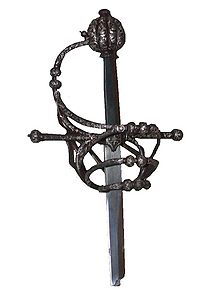Hilt

The hilt (sometimes called the haft) of a sword is its handle, consisting of a guard, grip and pommel. The guard may contain a crossguard or quillons. A tassel or sword knot may be attached to the guard or pommel.
Pommel
The pommel (the name is derived from the Latin for a "little apple") is a counterweight at the top of the handle. Even the lightest of modern fencing weapons use the weight of the pommel to provide a balance that the wielder prefers. In this sense, the pommel has remained one of the few parts of a sword that has, more than any other, retained its ancient function. Depending on sword design and swordsmanship style, the pommel may also be used to strike the opponent (e.g. using the Mordhau technique). Pommels have come in a wide variety of shapes, including crescents, oblate spheroids, semicircular, and disks. Various, more ornate designs are common in display or ceremonial swords. These pommels often include metal inlays, gemstones, jewels and even bone.
Grip
The grip is the handle of the sword. It was usually of wood or metal, and often covered with shagreen leather or shark skin. Shark skin proved to be the most durable in temperate climates but deteriorated in hot climates, and consequently rubber became popular in the latter half of the 19th century. Alternately, many sword types opt for ray skin instead, referred to in katana construction as the "same". Whatever material covered the grip, it was usually both glued on and held on with wire wrapped around it in a helix.
In full armored battle however, the grip was often only used with one hand (even on two-handed swords), and the blade was gripped partway up, thus allowing the fighter to thrust the blade horizontally, with both hands, into the opponent.
Guard
The guard protects the user's hand from the opponent's sword, and also prevents the user's hand from sliding up onto his own blade. This feature barely appears in the earliest swords, such as those of the Bronze Age in the 17th century BC. Later, guards often took the form of a straight crossbar ("quillon") perpendicular to the blade. Beginning in the 16th century in Europe, guards became more and more elaborate, with additional loops and curved bars or branches to protect the hand from cuts. Ultimately, the bars could be supplemented or replaced with metal plates that could be ornamentally pierced. The term "basket hilt" eventually came into vogue to describe such designs.
Simultaneously, emphasis upon the thrust attack with rapiers and smallswords revealed a vulnerability to thrusting. By the 17th century, guards were developed that incorporated a solid shield that surrounded the blade out to a diameter of up to two inches or more. Older forms of this guard retained the quillons or a single quillon, but later forms eliminated the quillons, altogether. This latter form is the basis of the guards of modern foils and épées.
Tassel

The tassel or sword knot is a lanyard -- usually of leather but sometimes of woven gold or silver bullion or more often metallic lace -- looped around the hand to prevent the sword being lost if it is dropped. Although they have a practical function, sword knots often had a decorative design. For example, the British Army generally adopted a white leather strap with a large acorn knot made out of gold wire for infantry officers at the end of the 19th century; such acorn forms of tassels were said to be 'boxed', which was the way of securing the fringe of the tassel along its bottom line such that the strands could not separate and become entangled or lost. Many sword knots were also made of silk with a fine, ornamental alloy gold or silver metal wire woven into it in a specified pattern.
The art and history of tassels are known by its French name, passementerie, or Posamenten as it was called in German. The military output of the artisans called passementiers (ornamental braid, lace, cord, or trimmings makers) is evident in catalogs of various military uniform and regalia makers of centuries past. The broader art form of passementerie, with its divisions of Decor, Clergy and Nobility, Upholstery, Coaches and Livery, and Military, is covered in a few books on that subject, none of which are in English.
Indian swords usually had the tassel attached through an eye right at the end of the pommel.
See also
- How to make a sword on Wikibooks
